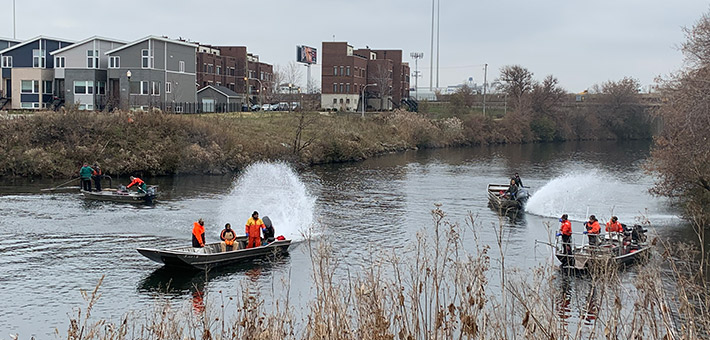No Asian carp found in two-week sampling of Bubbly Creek
November 22, 2019
Contacts:
Katie Steiger-Meister
U.S. Fish and Wildlife Service
612-723-4839
katie_steiger-meister@fws.gov

Boats on the Chicago River participating in Bubbly Creek response actions. Photo courtesy of IL DNR.
Chicago – The Illinois Department of Natural Resources (IDNR), and partner agencies under the leadership of the Asian Carp Regional Coordinating Committee (ACRCC), have found no Asian carp in the second week of searching for the invasive fish in the Chicago Area Waterway System (CAWS). Agencies jointly decided to pursue a two-week intensive survey of the area for live bighead and silver carps following the Oct. 30, 2019 notification of the presence of Asian carp environmental DNA (eDNA) in Bubbly Creek, which is part of the South Branch of the CAWS.
Read the November 8 announcement on week one results
Response efforts in the second week of monitoring mirrored the first week, including intensive netting and electrofishing near Bubbly Creek and the surrounding 10 miles of river by IDNR, U.S. Fish and Wildlife Service (USFWS) and the U.S. Army Corps of Engineers. In the second week of monitoring, agency biologists surveyed 166 sites, completing 22.5 hours of electrofishing and used contracted fishers to set and retrieve 11.6 miles of nets. A total of 1,693 fish were captured in these efforts, including 21 species and two hybrid groups. Gizzard shad, largemouth bass, and bluegill dominated the native fish catches this week, along with state threatened banded killifish. Common carp, a non-native species, was the second most abundant of all fishes surveyed. In total, 331 sites were visited during the two-week response, capturing more than 2,500 fish from waters in the 10 miles surrounding both the initial and follow-up eDNA detection sites. No bighead or silver carps were seen or captured.
Subsequent eDNA sampling in Bubbly Creek conducted by the U.S. Fish and Wildlife Service on Oct. 29 and 30, 2019 did detect additional eDNA positives. A total of 172 water samples were collected, of which 51 were found to be positive for silver carp eDNA, 21 were positive for bighead carp eDNA and 28 were positive for both bighead and silver carp eDNA. Notably, netting and electrofishing revealed no live fish present within Bubbly Creek where positive eDNA was detected.
During the second round of eDNA collection in Bubbly Creek, biologists observed the start of a combined sewer overflow event. Given that the water quality in this area of Bubbly Creek is unlikely to support live fish, agencies will continue to investigate other potential sources of eDNA, as well as potential connections between the observed combined sewer overflow event and the unusual eDNA results.
“We’re extremely pleased with the absence of invasive carps during this week’s monitoring,” said Kevin Irons, aquaculture and aquatic nuisance species program manager, IDNR. “Given that no bighead or silver carp were found, the ACRCC will proceed with scheduled sampling in spring 2020, looking for both live fish and eDNA in the ongoing effort to protect the Great Lakes from Asian carp.
To aid monitoring efforts, the U.S. Army Corps of Engineers canceled testing at the barriers planned for Nov. 20-22, 2019, which would have required the two most upstream barriers to be powered down.
“The transition to cold weather operations at the barriers, which involves powering down one half of Barrier II and operating the other half at reduced voltage settings when water temperatures drop below 10 degrees Celsius were postponed to allow the ACRCC and partner agencies to finalize the response actions and any prudent follow up measures deemed necessary,” said W. Patrick Bray, chief of public affairs for the Chicago District of the U.S. Army Corps of Engineers.
With no live bighead or silver carp detected or captured, the ACRCC’s normal monitoring efforts in the CAWS will resume as scheduled. The CAWS, including the vicinity of Bubbly Creek, is intensively sampled each year through a comprehensive, multipronged interagency sampling plan focusing on the detection of Asian carp in the waterways between the electric dispersal barriers and Lake Michigan. Additional information about Asian carp monitoring efforts, as well as the ACRCC’s response plans, can be found at www.asiancarp.us.
